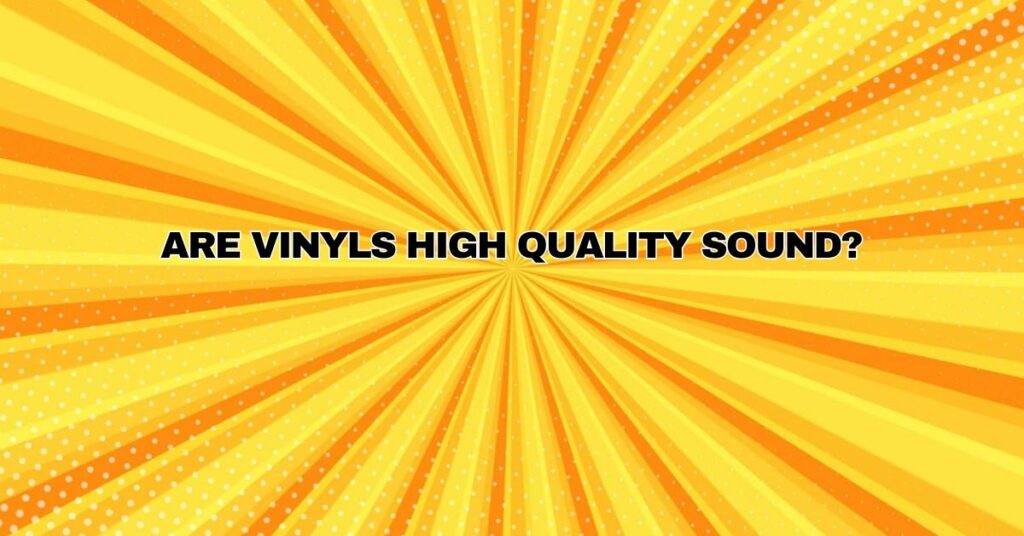Vinyl records have long held a special place in the hearts of audiophiles and music enthusiasts. Many enthusiasts swear by the warm, analog sound of vinyl, claiming it to be the pinnacle of high-quality audio. However, the question remains: Are vinyl records truly synonymous with high-quality sound, or is it a matter of nostalgia and subjective preference? In this comprehensive analysis, we’ll explore the characteristics of vinyl sound, its advantages, limitations, and how it compares to other audio formats.
The Analog Warmth of Vinyl
Vinyl records are celebrated for their unique sonic qualities, often described as warm, rich, and immersive. Here are some of the characteristics that contribute to the perception of vinyl as high-quality sound:
- Analog Nature: Vinyl records are analog by nature, meaning they reproduce sound in a continuous waveform. This contrasts with digital formats, which represent sound as discrete numerical values. Many listeners find the analog nature of vinyl to be more faithful to the original recording.
- Dynamic Range: Vinyl records can reproduce a wide dynamic range, capturing both the softest and loudest passages of music with greater subtlety than some digital formats. This dynamic range contributes to a more natural and engaging listening experience.
- Tactile Experience: Handling vinyl records and manually placing the stylus on the spinning disc is a tactile experience that adds to the enjoyment of music. This hands-on interaction is an integral part of the vinyl appeal.
- Album Art and Packaging: Vinyl records often feature larger album art and extensive packaging, providing a visual and tactile connection to the music that digital formats can’t replicate.
- Audio Artifacts: Vinyl records may introduce audio artifacts such as surface noise, pops, and crackles. Paradoxically, these imperfections are sometimes perceived as part of the charm, contributing to the vintage character of vinyl sound.
The Advantages of Vinyl Sound
While vinyl records have their unique characteristics, they also offer several advantages that contribute to their reputation for high-quality sound:
- Analog Warmth: Vinyl’s analog nature can produce a warm and organic sound that many listeners find pleasing, especially for genres like jazz, blues, and classic rock.
- Richness and Depth: Vinyl records can convey a sense of depth and dimensionality in music, making instruments and vocals feel more tangible and real.
- Dynamic Range: Vinyl’s ability to capture a wide dynamic range allows for nuanced and detailed music reproduction.
- Mastering Choices: Some vinyl releases are carefully mastered to optimize the sound for the medium, enhancing their sonic qualities.
The Limitations of Vinyl Sound
While vinyl has its strengths, it also has limitations that affect its perceived quality:
- Surface Noise: Vinyl records can produce surface noise, pops, and crackles, which can be distracting and reduce overall audio fidelity.
- Wear and Tear: With each play, vinyl records undergo physical wear, potentially degrading sound quality over time.
- Imperfections: Vinyl records can suffer from manufacturing imperfections, including warps and pressing defects, which can negatively impact sound quality.
- Frequency Response: Vinyl records have limitations in high-frequency response, which may not reproduce the extreme highs and lows found in some digital formats.
- Inconsistent Playback: The quality of playback can vary depending on the turntable, cartridge, stylus, and overall setup, making consistency a challenge.
How Vinyl Compares to Other Formats
The debate over vinyl’s sound quality often involves comparisons to other audio formats, primarily digital. Here’s how vinyl stacks up against some common formats:
- Digital Formats: Digital formats like CD and high-resolution audio (e.g., FLAC or WAV) offer pristine sound quality, with no surface noise or degradation. However, some listeners find vinyl’s analog warmth more appealing for certain genres.
- Streaming: Streaming services offer convenience and access to vast libraries of music, but audio quality can vary. Some streaming services offer high-quality audio, but vinyl enthusiasts argue that vinyl surpasses the streaming experience in terms of depth and warmth.
- Lossy Formats: Formats like MP3, while highly compressed for convenience, typically sacrifice some audio quality for file size reduction. Vinyl is often considered superior in terms of sound quality.
Conclusion
The perception of vinyl records as high-quality sound is deeply rooted in their unique analog characteristics, analog warmth, and tactile experience. While vinyl has its limitations, including surface noise and susceptibility to wear, its enduring appeal lies in its ability to convey music with a sense of depth, richness, and dynamic range that resonates with many listeners. Ultimately, the appreciation of vinyl sound is subjective, and what matters most is the emotional connection and enjoyment it brings to those who choose to embrace this enduring medium. Vinyl records offer a nostalgic and audiophile-approved way to experience music, whether as a hobby or a genuine preference for their distinctive sonic qualities.


